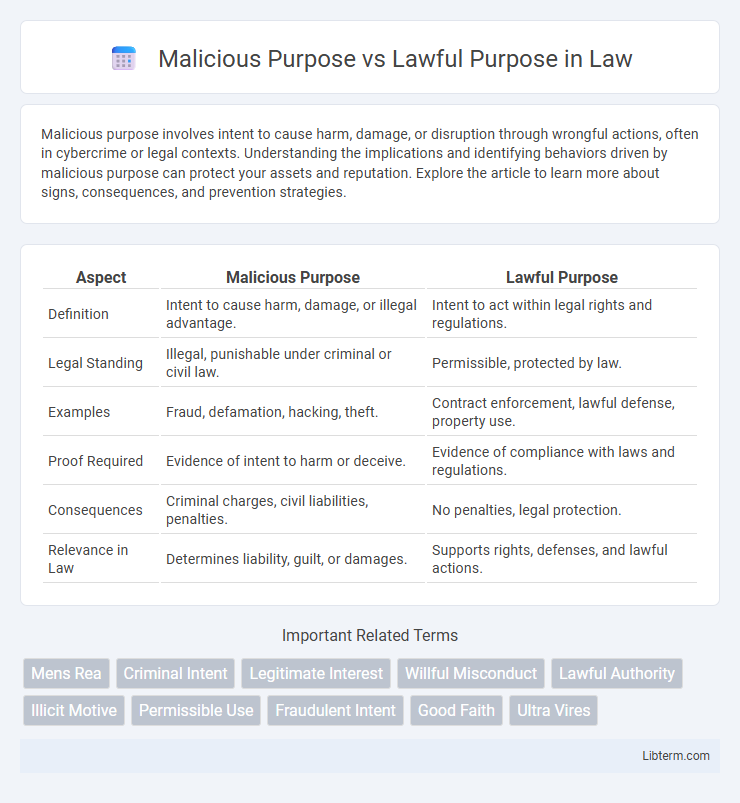Malicious purpose involves intent to cause harm, damage, or disruption through wrongful actions, often in cybercrime or legal contexts. Understanding the implications and identifying behaviors driven by malicious purpose can protect your assets and reputation. Explore the article to learn more about signs, consequences, and prevention strategies.
Table of Comparison
| Aspect | Malicious Purpose | Lawful Purpose |
|---|---|---|
| Definition | Intent to cause harm, damage, or illegal advantage. | Intent to act within legal rights and regulations. |
| Legal Standing | Illegal, punishable under criminal or civil law. | Permissible, protected by law. |
| Examples | Fraud, defamation, hacking, theft. | Contract enforcement, lawful defense, property use. |
| Proof Required | Evidence of intent to harm or deceive. | Evidence of compliance with laws and regulations. |
| Consequences | Criminal charges, civil liabilities, penalties. | No penalties, legal protection. |
| Relevance in Law | Determines liability, guilt, or damages. | Supports rights, defenses, and lawful actions. |
Defining Malicious and Lawful Purposes
Malicious purpose involves intent to cause harm, damage, or unlawful advantage through actions such as fraud, theft, or cyberattacks, characterized by deception or violation of legal standards. Lawful purpose refers to actions and intentions that comply with legal frameworks, ethical norms, and regulatory requirements, supporting legitimate activities like data protection and authorized access. Distinguishing these purposes is critical in cybersecurity, intellectual property law, and contract enforcement to determine liability and enforce compliance.
Legal Frameworks Differentiating Intent
Legal frameworks distinguish malicious purpose from lawful purpose primarily through the intent behind an action, assessing whether it aims to cause harm or complies with established laws. Criminal laws, such as fraud or cybercrime statutes, require proving malicious intent, while lawful purposes are protected under regulations permitting legitimate activities like consented data access or authorized transactions. Courts evaluate evidence of intent through actions, communications, and context to uphold legal accountability and safeguard legitimate rights.
Common Examples of Malicious Purposes
Common examples of malicious purposes include unauthorized data breaches, identity theft, and launching malware attacks such as ransomware or spyware aimed at causing harm or financial loss. Phishing schemes designed to deceive individuals into revealing sensitive information and unauthorized system intrusions with intent to disrupt operations or steal intellectual property also represent typical malicious activities. These actions contrast with lawful purposes, which involve authorized access, data protection, and ethical use of technology for legitimate business or personal objectives.
Lawful Activities and Their Justifications
Lawful activities encompass actions sanctioned by legal frameworks, such as contractual agreements, peaceful protests, and legitimate business transactions, which serve to uphold social order and protect individual rights. These activities are justified through adherence to statutory laws, ethical standards, and judicial precedents that define acceptable conduct within a given jurisdiction. Understanding lawful purposes is critical in distinguishing them from malicious intents, which involve unauthorized or harmful actions aimed at causing damage or violating legal rights.
The Role of Intent in Legal Proceedings
The role of intent is paramount in distinguishing malicious purpose from lawful purpose in legal proceedings, as courts assess whether actions were carried out with ill will or legitimate objectives. Proving malicious intent often requires demonstrating knowledge of wrongdoing or reckless disregard for legal duties, which can influence the severity of penalties. Conversely, establishing lawful purpose involves showing good faith, compliance with laws, and absence of harmful intent, which may lead to exoneration or reduced liability.
Consequences of Malicious Intent in Law
Malicious intent in law results in severe legal consequences including enhanced penalties, criminal liability, and potential civil damages due to the deliberate harm caused. Courts often impose stricter sentences for actions driven by malice to deter intentional wrongdoing and protect public interests. Proof of malicious purpose shifts burden to defendants, increasing their risk of conviction and compensatory responsibilities.
Establishing Lawful Purpose: Key Criteria
Establishing lawful purpose requires clear evidence that the use of data or actions complies with applicable regulations such as the GDPR or CCPA, ensuring legitimacy and transparency. Key criteria include obtaining valid consent, specifying the purpose explicitly, and demonstrating necessity for business operations or legal obligations. Documentation and audit trails play a crucial role in verifying that purposes align with statutory requirements and do not serve malicious intent.
Case Studies: Malicious vs Lawful Actions
Case studies contrasting malicious versus lawful purposes illustrate clear distinctions in intent and consequence; for example, the 2017 Equifax data breach involved malicious cyberattacks aiming to steal sensitive personal information, while lawful cybersecurity research in the same domain helps identify vulnerabilities to prevent such breaches. In another study, whistleblowers exposing corporate fraud highlight lawful purpose actions that serve the public interest, contrasting with malicious insider threats that exploit confidential data for personal gain. These examples emphasize the critical role of intent in defining actions as either malicious or lawful within legal and ethical frameworks.
Preventing Misuse: Regulatory Measures
Regulatory measures such as stringent data protection laws and strict access controls are essential in preventing the misuse of technology for malicious purposes. Implementing comprehensive auditing and monitoring systems helps detect unauthorized activities, ensuring lawful use aligns with established compliance standards. Enhanced cybersecurity protocols and clear legal frameworks provide a robust defense against exploitation while promoting responsible innovation.
Navigating Gray Areas: Practical Guidelines
Navigating gray areas between malicious purpose and lawful purpose requires a clear understanding of intent and context in actions, especially in cybersecurity and intellectual property domains. Practical guidelines include thorough documentation, seeking legal counsel before proceeding with potentially ambiguous activities, and adhering to industry standards to ensure activities align with lawful objectives. Implementing risk assessments and maintaining transparency with stakeholders minimizes the likelihood of misinterpretation and legal complications.
Malicious Purpose Infographic

 libterm.com
libterm.com